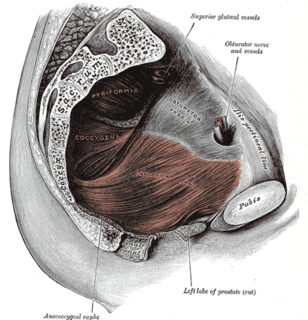| Anal fascia | |
|---|---|
Coronal section of pelvis, showing arrangement of fasciae. Viewed from behind. | |
| Identifiers | |
The anal fascia is the inferior layer of the diaphragmatic part of the pelvic fascia, which covers both surfaces of the levatores ani. It is attached above to the obturator fascia along the line of origin of the levator ani, while below it is continuous with the superior fascia of the urogenital diaphragm, and with the fascia on the sphincter ani internus.

The pelvic fasciae are the fascia of the pelvis and can be divided into:

The levator ani is a broad, thin muscle, situated on either side of the pelvis. It is formed from three muscle components: the pubococcygeus, the iliococcygeus, and the puborectalis.

The obturator fascia, or fascia of the internal obturator muscle, covers the pelvic surface of that muscle and is attached around the margin of its origin.
The layer covering the upper surface of the pelvic diaphragm follows, above, the line of origin of the levator ani and is therefore somewhat variable.
In front it is attached to the back of the pubic symphysis about 2 cm. above its lower border.

The pubic symphysis a cartilaginous joint that sits between and joins left and right the superior rami of the pubic bones. It is located in front of and below the urinary bladder. In males, the suspensory ligament of the penis attaches to the pubic symphysis. In females, the pubic symphysis is intimately close to the clitoris. In normal adults it can be moved roughly 2 mm and with 1 degree rotation. This increases for women at the time of childbirth.
It can then be traced laterally across the back of the superior ramus of the pubic bone for a distance of about 1.25 cm, when it reaches the obturator fascia.

The superior pubic ramus is a part of the pubic bone which forms a portion of the obturator foramen. The obturator foramen, along with the ilium and other fused bones, forms part of either side of the pelvis.

In vertebrates, the pubic bone is the ventral and anterior of the three principal bones composing either half of the pelvis.
It is attached to this fascia along a line which pursues a somewhat irregular course to the spine of the ischium.

From the posterior border of the body of the Ischium there extends backward a thin and pointed triangular eminence, the ischial spine, more or less elongated in different subjects.

The ischium forms the lower and back part of the hip bone.
The irregularity of this line is because the origin of the levator ani, which in lower forms is from the pelvic brim, is in man lower down, on the obturator fascia.
Tendinous fibers of origin of the muscle are therefore often found extending up toward, and in some cases reaching, the pelvic brim, and on these the fascia is carried.











